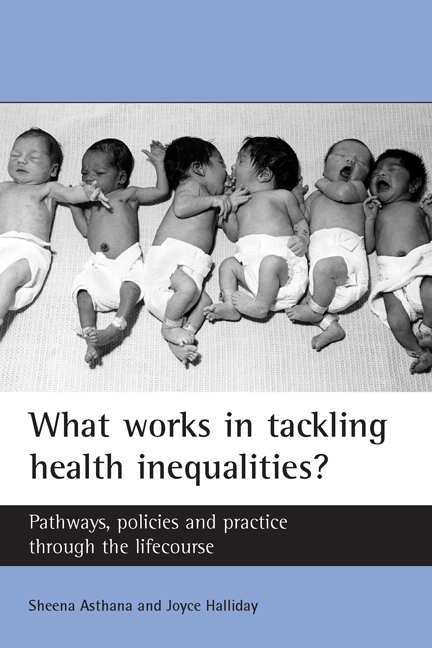Book contents
- Frontmatter
- Dedication
- Contents
- List of tables, boxes and figure
- Acknowledgements
- List of abbreviations
- one Introduction
- Part 1 The research and policy context of health inequalities
- Part 2 Health inequalities pathways, policies and practice through the lifecourse
- Part 3 Tackling health inequalities: developing an evidence base for public health
- Index
nine - Inequalities in the health behaviour of children and youth: policy and practice
Published online by Cambridge University Press: 14 January 2022
- Frontmatter
- Dedication
- Contents
- List of tables, boxes and figure
- Acknowledgements
- List of abbreviations
- one Introduction
- Part 1 The research and policy context of health inequalities
- Part 2 Health inequalities pathways, policies and practice through the lifecourse
- Part 3 Tackling health inequalities: developing an evidence base for public health
- Index
Summary
Introduction
Normal childhood and adolescent development is arguably characterised first by immature and then by inconsistent behaviour, compounded by a sense of invulnerability, experimentation, and a limited concern for future health. This scenario is complicated by two quite different imperatives. On the one hand, young people now face earlier and more intensive exposure to high-risk behaviour, with social and media attitudes encouraging them to look and act older than their years (NSNR, 2000). On the other hand, as Chapter Six has established, there is an increasing delay before the vast majority of adolescents achieve financial and domestic independence. There is thus an extended period post-adolescence where one can no longer assume a requirement to conform and where conspicuous consumption may be an important motivation (Parker et al, 1998).
Social variations are manifest in these risk behaviours and, as Chapter Eight demonstrated, childhood and adolescence, long-held as a period of relative equality in health, is now increasingly perceived as a period of extreme inequality in terms of health behaviour and attendant risk with both immediate and long-term implications. The risk-taking behaviours that can be described as problematic in childhood and youth, such as smoking, drinking, other drug use, early sexual activity and poor eating habits, are all associated with one another (Tyas and Pederson, 1998). The recent attention given to the so-called obesity epidemic has helped extend the profile of social concern to still younger children, albeit with a more explicit focus on health.
The complex relational web between risk factors and detrimental outcomes militates against compartmentalisation. It demands that the connections are made, challenging the preoccupation with symptoms rather than causes and pointing to the need to address the whole person, not just one or two risk factors (Millward et al, 2004). This chapter focuses on three significant areas where health behaviour is markedly unequal, that is: diet and nutrition; substance abuse; and sexual health; together with education and employment.
Diet and nutrition
Poor diet in childhood, as Chapter Eight has shown, is associated with both poor child and later adult health. Interventions fall under two related heads. First, there have been long-standing efforts to improve nutritional status, by both food supplementation (ranging from the school-based provision of milk and school meals to the current focus on fruit and vegetables) and efforts to address food poverty.
- Type
- Chapter
- Information
- What Works in Tackling Health Inequalities?Pathways, Policies and Practice through the Lifecourse, pp. 323 - 372Publisher: Bristol University PressPrint publication year: 2006



